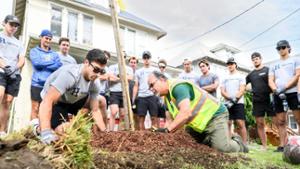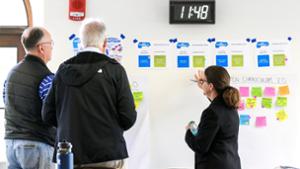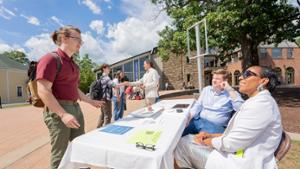“What If” Initiative Turns Ideas into Action
“We know there are a lot of great courses and programs related to health happening across campus, but it feels very fragmented,” said Natalie Nannas, associate professor of biology. “There’s a thirst for more cohesion.”
That’s where the Hamilton Health and Humanity (H3) Initiative comes in. Led by Nannas and a team of faculty collaborators, H3 is working to identify and connect the many health-related efforts already underway at Hamilton — from courses and research projects to co-curricular programs and community partnerships. The group hopes to build a clearer picture for students of Hamilton’s strengths in health and wellness and lay the groundwork for future interdisciplinary collaboration.
The lunch drew participants from departments and offices across campus — from Biology, Women and Gender Studies, Economics, and History to the Levitt Center, Career Center, Community Health Promotion, and the Wellin Museum of Art. The conversation illustrated both how deeply health touches every part of Hamilton’s community and mission, and how many people at the College are passionate about it.
Reimagining What’s Possible
The H3 Initiative is one of 19 projects to receive seed funding through a community-wide experiment in creativity and collaboration launched by President Steven J. Tepper during his inauguration in September 2024. In his inaugural address, Tepper challenged the Hamilton community with a simple but powerful question: What if?
That question became the foundation of the “What If” Initiative — the College’s newest experiment in community-driven innovation. Designed to surface bold ideas that could shape Hamilton’s future, the initiative invited faculty, staff, and students to imagine new ways to enhance life and learning on College Hill.
The response was extraordinary. More than 300 “What if” questions poured in from every corner of campus life during the first phase. As conversations unfolded and ideas evolved, many of those early submissions converged into 51 formal proposals. Of those, 19 were selected to receive seed funding to pilot ideas, test prototypes, and build collaborations that could grow into larger efforts down the road.
Throughout this academic year, faculty, staff, and students are refining, testing, and collaborating on these ideas — turning proposals into programs and partnerships that could carry them forward. Some teams are launching new programs, while others are using the seed funds to explore feasibility, gather data, or design prototypes for future phases.
Early results are already visible: one funded idea helped the men’s hockey team offset its travel emissions by planting trees in nearby Utica, combining athletics, sustainability, and community engagement in a way that reflects the initiative’s spirit.
Not every idea needed funding to take root. A handful of suggestions shared early on gained traction simply because people ran with them. A faculty and staff meal plan? That’s now a thing. And a student-led push for milkshakes on campus — which inspired 18 milkshake-related ideas during the submission period — became a campus reality this fall when McEwen Dining Hall began offering them.



A New Model for Innovation
For Tepper, the “What If” Initiative is more than a one-time experiment. It’s a model for how Hamilton can continue to evolve. It reflects his belief that innovation at a liberal arts college should be participatory, collaborative, and rooted in the creativity of its people.
“The “What If” process demonstrated the imagination and energy that thrive on College Hill,” Tepper said in a message announcing the accepted proposals. “Each idea and proposal is part of a broader wave of momentum shaping Hamilton’s next chapter.”
What If...
From reimagined curricular pathways and new forms of experiential learning to environmental initiatives and community partnerships, the funded projects touch nearly every dimension of life and learning on the Hill.
Among the 19 projects selected for funding were ideas to:
- Build a nanobrewery as an interdisciplinary learning lab
- Train students in entrepreneurship through a mentorship pipeline
- Establish a General Experiential Learning Fund to support all students in exploring learning opportunities that enhance their academic and professional growth
- Pilot a program with Levitt Center’s Justice Lab to enhance public writing
- Expand F.I.L.M. into a central interdisciplinary film initiative
More Hamilton Stories

Good News from the Hill: 2024-25 Highlights
From groundbreaking ideas to game-winning goals, the 2024-25 academic year was full of energy and momentum.

The Open Thinker Meets the Open Curriculum
“Creativity and innovation are in the DNA of Hamilton College,” says Steven Tepper, Hamilton's 21st president. “Our namesake and original trustee, Alexander Hamilton, was our nation’s creative founding father. Other founding fathers were content with borrowed models or sticking to the old agrarian order. Hamilton knew that a new nation needed new ideas. Ever since, the College’s history has been punctuated by moments of innovation and creativity and invention.”

